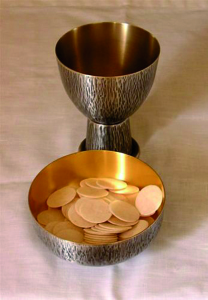‘We must therefore consider the Eucharist as: — thanksgiving and praise to the Father ; — the sacrificial memorial of Christ and his Body; — the presence of Christ by the power of his word and of his Spirit .’ (CCC 1358) The above quote from the Catechism of the Catholic Church lists the three defining elements of the celebration of the Eucharist, Mass.
Thanksgiving
‘The Eucharist is a sacrifice of thanksgiving to the Father, a blessing by which the Church expresses her gratitude to God for all his benefits, for all that he has accomplished through creation, redemption and sanctification. Eucharist means first of all ‘thanksgiving’.’ (CCC 1360)
Mass is a special way in which we can evidence our thanksgiving to God for all the wonders he has done for us. We thank him for his work of creation, for all the created things we know and love included our family and friends. His work of redemption which saw him give over his only Son to an excruciating death on the Cross, so as to save us from the powers of the evil one and an eternity in Hell.
Finally, we thank him for his work of sanctification, that is, His work of making us holy and preparing us for an eternity in Heaven with him.
Memorial
We are all familiar with the narrative of the Last Supper and the institution of the Eucharist: ‘Then he took a loaf of bread, and when he had given thanks, he broke it and gave it to them, saying, “This is my body, which is given for you. Do this in remembrance of me.” And he did the same with the cup after supper, saying, “This cup that is poured out for you is the new covenant in my blood.”’ (Luke 22:19-20) We recognise that ‘The Eucharist is the memorial of Christ’s Passover, the making present and the sacramental offering of his unique sacrifice, in the liturgy of the Church which is his Body.
In all the Eucharistic Prayers we find after the words of institution a prayer called the anamesis or memorial.’ (CCC 1362) Jesus instituted the Eucharist at the Last Supper, celebrating the first Mass with his disciples, who would go on to offer the first Masses for the early Church.
Each Holy Thursday (and indeed every Thursday when we reflect on the Fifth Luminous Mystery) we are reminded in a special way of the Last Supper and the profound sacrifice Jesus offered for us. And each Sunday we participate in a liturgy that dates all the way back to Jesus himself, where the priest who is acting in persona Christi re-presents the Eucharistic sacrifice that our Saviour asked us to do in memory of him. But of course, this memorial we undertake holds another profound element.
Presence
‘The mode of Christ’s presence under the Eucharistic species is unique. It raises the Eucharist above all the sacraments as “the perfection of the spiritual life and the end to which all the sacraments tend.” In the most blessed sacrament of the Eucharist “the body and blood, together with the soul and divinity, of Our Lord Jesus Christ and, therefore, the whole Christ is truly, really, and substantially contained.” “This presence is called ‘real’ – by which is not intended to exclude the other types of presence as if they could not be ‘real’ too, but because it is present in the fullest sense: that is to say, it is a substantial presence by which Christ, God and man, make himself wholly and entirely present.”’ (CCC 1374)
This is the element of the Eucharist that should blow our mind – to speak colloquially. However, we tend to really struggle with this mystery of faith. Sadly, there are many who consider the consecrated bread and wine at Mass to be only what they appear to be: bread and wine. They consider them to be only symbols of the Passover meal Jesus shared with his disciples, signs of his body and blood.
However, through faith, we know that after the words of consecration, Jesus is really and truly present. We can’t see him insofar as he still has the appearance of bread and wine, but he’s there nonetheless.
We may not have all seen Eucharistic miracles – or the relics of such – but there are many events in the Church’s history where this mystery of faith has been demonstrated for we who find it hard to believe. Consecrated hosts have bled onto corporals, some have turned visibly into flesh and all this reveals one truth. Jesus is there. Truly present.
Mass is a beautiful and poignant reminder of the love of our God for us. How blessed are we that in participating in this liturgy we are all at once giving thanksgiving to God, remembering Christ’s sacrifice and in the presence of that same Saviour? Perhaps it goes without saying, but we are very blessed indeed.
Originally posted 2014-12-23 22:16:37.


Dear Sir / Madam
I would like to use the photo of the chalice and ciborium filled with the host and precious blood for an evangelising postcard that I am designing. Could I request your permission to use it?
Hi There, thankyou for asking. We don’t own this photo, but used it from a collection of Stock photos we purchased. So can’t really give permission for it. If you are looking for free stock images perhaps check out this website >> http://photos.ecatholic.com/gallery/freestockphotos/ God bless!